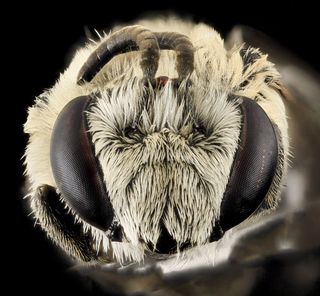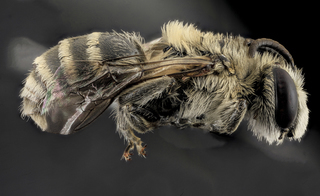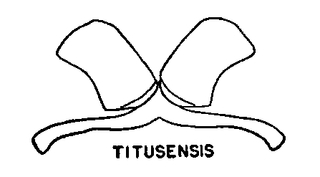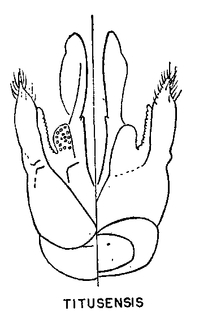|
| Links | Male Holotype seen at AMNH, very worn, in moderately poor condition
|
80x5 -
240x3 -
240x4 -
320x1 -
320x2 -
320x3 -
640x1 -
640x2
Set display option above.
Click on
images to enlarge. |

© Copyright source/photographer
· 5
Colletes titusensis, M, Face, Brevard co., Honda, U.S |

© Copyright source/photographer
· 5
Colletes titusensis, M, Side, Brevard co., Honda, U.S |
|

Mitchell, Bees of the Eastern United States, Vol. I, 1960 · 1
Colletes titusensis, figure10i |

© Mitchell, 1960
· 1
Colletes titusensis, genital armature |
|
Overview |
Reprinted with permission from: Mitchell, T.B. 1960 Bees of the Eastern United States. North Carolina Agricultural Experiment Station Technical Bulletin No. 141.
FEMALE—Length 8 mm.; face slightly longer than greatest distance between eyes; eyes convergent below; malar space linear; facial foveae quite short, rather shallow except along margin of eye, somewhat rounded above, terminating close to upper end of eye; clypeus rounded, protruding very slightly below suborbital line, closely, deeply and rather finely and uniformly punctate, the punctures becoming somewhat obscure along apical margin; supraclypeal area largely impunctate; punctures of face above antennae somewhat more coarse and more distinctly separated, those on vertex minute and irregular, the surface shining, those on cheeks minute and rather close above, becoming somewhat deeper and more distinct but still quite close below; antennae blackish, segments of flagellum somewhat broader than long, but the basal segment at least twice as long as the 2nd; vertex and dorsum of thorax with some pale brownish-fuscous pubescence, pubescence of face, cheeks and thorax laterally and posteriorly largely white, and that on legs largely white, including the scopa; lateral angles of pronotum acute but not spine-like; metapleural protuberance very low, barely evident, entirely black; front coxae not spined; legs including tarsi largely blackish, spurs fuscous, hind basitarsi about three times longer than broad; tegulae brownish-fuscous; wings lightly infuscated, veins and stigma fuscous; scutum closely, deeply and rather coarsely punctate across anterior half and laterally, center of posterior half of disc impunctate; scutellum with scattered, rather close punctures, except along anterior margin; punctures of pleura deep and contiguous, almost rugose above, but those in hypoepimeral area distinctly separated, rather sparse along lower margin; dorsal area of propodeum narrow, striate, forming a series of rectangular pits, lateral faces dull, very finely roughened, posterior face sub- reticulate; 1st and 2nd abdominal terga shining, punctures rather evenly distributed, but very minute and obscure, following segments rather dull, more closely but still minutely punctate, the white apical fasciae interrupted on terga 1 and 2, more nearly complete on the following segments, discal pubescence very short, thin and inconspicuous, apparently entirely pale.
MALE—Length 8 mm.; length of face very slightly exceeding its greatest breadth; eyes convergent below; malar space linear, nearly obliterated; antennae dull ferruginous beneath, median segments short, hardly longer than broad, basal segment of flagellum much longer than the 2nd, which is broader than long; clypeus with fine, crowded and rather deep punctures beneath the dense and rather short pubescence; face above antennae more shining, deeply, closely, distinctly and rather coarsely punctate; vertex shining, irregularly and rather closely punctate; cheeks shining between the quite close and deep punctures; lateral angles of prothorax sharply acute, but not spined; metapleural protuberance not car- mate; tegulae shining ferruginous; wings subhyaline, veins and stigma fuscous; punctures of scutum deep and distinct, close over most
disc, rather coarse, becoming coarser and rather sparse in center posteriorly, those on scutellum coarse, deep and well separated, anterior margin shining and impunctate; pleura coarsely, deeply and closely punctate throughout; lateral faces of propodeum finely rugose, dorsal face short, with shining quadrangular spaces formed by the parallel striae; legs dark, the apical tarsal segments becoming ferruginous, length of hind basitarsi about three times the breadth, spurs yellowish-ferruginous; abdominal terga smooth, somewhat shining, punctures minute, well separated on disc of basal segment, becoming closer and more minute and obscure on the more apical segments; apical margins of terga depressed, reddish on the more apical segments beneath the entire white fasciae; pubescence entirely whitish, without dark admixture, discal pubescence obscure, very short and erect.
DISTRIBUTION—Recorded only from Florida, where it is in flight during April and May.
FLOWER RECORDS—No flower-visiting records are available.
|
|
|
Names | |
|
|
| Supported by | |
Updated: 2024-04-19 22:20:53 gmt
|